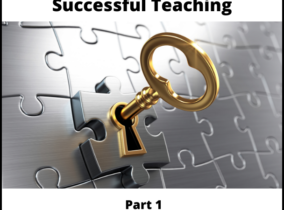In part 1 of this series, I began to identify ‘Keys to Successful Teaching’.
The first key: Create a positive learning environment.
Thefirst step: Become a purposeful role-model.
In this article, I will outline the second step: Having High Expectations

Having high expectations (both academic and behavioral) is key to setting your students up to succeed.
A teacher’s expectations, either high or low expectations, become a self-fulfilling prophecy. Students perform in ways that teachers expect. (source)
Academic Expectations
Research shows that having high expectations for academic achievement is very important. Even students with learning challenges need to be challenged and deserve a teacher that believes that they can and will succeed.
Where do high expectations begin? They begin with you, the teacher. Have high expectations for yourself:
- Be prepared and organized every day.
- Take the time to know each student’s strengths and weaknesses.
- Provide challenging, thought provoking lessons based on the level(s) of your students.
- Be flexible in your teaching style.
- Provide additional teaching when students require it.
- Give fair and specific feedback consistently, more than just ‘good job.’
- Maintain a positive attitude toward students and their abilities.
Once you have set the expectations for yourself. It is time to set them for your students. What will you expect from them? Do you expect them to come to class ready to learn? Do you expect them to be accountable? Will you accept excuses or half answers, or will you expect them to participate fully and up to a level that they will need to ‘work’ to learn?
Again, I’m going to emphasis that high expectations begin with you. You must be prepared to be consistent in the high level of support that you need and should give. It can be much easier to ‘let things slide’ but don’t let that happen. Your students can and will achieve great things when you are their cheerleader.
If you are up to the tasks listed above, you are ready to have high expectations for your students. Create them and then communicate them. How do you do this?
- Post your expectations where they can be see daily. One suggestion in doing this is placing posters with inspirational quotes throughout the learning space. Here are a few examples:
- “Many of life’s failures are people who did not realize how close they were to success when they gave up.” ~ Thomas Edison
- “If we did the things we are capable of, we would astound ourselves.” ~ Thomas Edison
- “Courage is doing what you’re afraid to do. There can be no courage unless you’re scared.” ~ Eddie Rickenbacker
- Have students sign an ‘achievement contract’. If you have never seen a student achievement contract and are unsure how to compose one, I have a FREE download for you! (Get your copy at the end of this article.)
- Keep a dialogue open with your students about your expectations. If you teach in a classroom or co-op, you can opt to dialogue through journaling back and forth with each student. If you are a homeschooling parent, set time aside specifically to talk about expectations.
- Using expanded questioning techniques with students throughout the learning process will let students know that you believe in their academic abilities. Here are some examples:
- ” Show me more.”
- ” What do you plan to do next?”
- ” That looks like it took a lot of effort. How did you figure that out?”
- ” Tell me what you think the next step in the process should be. Why?”
- Expect students to revise their work when you know they haven’t worked up to their ability. In doing this, make sure to provide additional assistance as needed so that they can achieve the objectives you have set for them.
Behavioral Expectations
I’m not going cover behavioral expectations in depth in this article. However, the same facts hold true here as well…
- You must exemplify high behavioral standards for yourself in the classroom.
- You must set specific behavioral expectations for students.
- You must communicate clearly what is expected.
Doing these things WILL help you develop and maintain a positive learning environment for your students.



